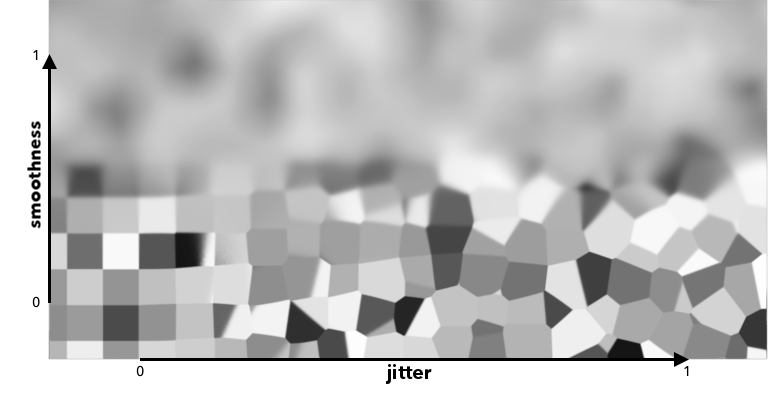PxrVoronoise
PxrVoronoise

Like all texture style nodes, this node takes a manifold that describes either a 2D or 3D domain to apply a voronoise texture to. The default behavior if no mainfold is attached is to apply over P in 3D. This node computes the voronoise function, which is a blend of noise and Voronoi as described by Inigo Quilez.
The jitter and smoothness parameters allow you to create different types of patterns.
- jitter=0,smoothness=0 produces a minimum distance non-jittered grid of values, like RSL's cellnoise.
- jitter=0,smoothness=1 gives a noise function, similar to perlin's.
- jitter=1,smoothness=0 produces a jittered, minimum distance Voronoi pattern.
- jitter=1,smoothness=1 produces a a combination of jittered Voronoi and noise, "voronoise".
Note, this version also adds fractal octaves and turbulence.
Input Parameters
Frequency
Sets the lowest (starting) frequency of the noise layers.
RIB: float frequencyDefault: 1.0
Octaves
The number of noise octaves used. More octaves add successively more noise.
RIB: int octavesDefault: 3
Gain
Also known as persistence. Used to shrink or expand the amplitude of each successive octave of noise. 1/f noise is achieved when gain = 1/lacunarity
RIB: float gainDefault: 0.5
Lacunarity
The scaler used to determine the frequency of each sucessive octave of noise. Smaller numbers will cause the layers to be more closely spaced in frequency. Larger values will space them further apart.
RIB: float lacunarityDefault: 2.0
Jitter
Controls the amount of jitter applied. 0 gives regular grid, 1 gives a Voronoi like grid
RIB: float jitterDefault: 0.0
Smoothness
Using 0 produces a voronoi/cellnoise pattern, 1 results in smooth noise.
RIB: float smoothnessDefault: 1.0
Turbulent
Should the noise be turbulent
RIB: int turbulentDefault: 0
Manifold
The manifold over which to apply the noise. (The default is P).
RIB: struct manifold
Output Parameters
- resultF
- The result of voronoise texture.
